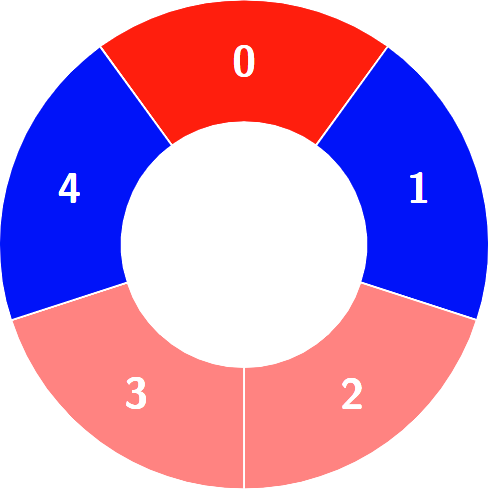Alternating Groups 1
EasyUpdated: Aug 2, 2025
Practice on:
Problem
There is a circle of red and blue tiles. You are given an array of integers colors. The color of tile i is represented by colors[i]:
colors[i] == 0means that tileiis red.colors[i] == 1means that tileiis blue.
Every 3 contiguous tiles in the circle with alternating colors (the middle tile has a different color from its left and right tiles) is called an alternating group.
Return the number of alternating groups.
Note that since colors represents a circle, the first and the last tiles are considered to be next to each other.
Examples
Example 1:
Input: colors = [1,1,1]
Output: 0
Explanation:

Example 2:
Input: colors = [0,1,0,0,1]
Output: 3
Explanation:
 Alternating groups:
Alternating groups:



Constraints:
3 <= colors.length <= 1000 <= colors[i] <= 1
Solution
Method 1 – Sliding Window with Modulo
Intuition
Since the tiles form a circle, we can use a sliding window of size 3 and wrap around using modulo. For each window, we check if the middle tile is different from both its neighbors. This way, we count all valid alternating groups efficiently.
Approach
- Let
nbe the length ofcolors. - Initialize
ansto 0. - For each index
ifrom 0 ton-1:
- Let
a = colors[i] - Let
b = colors[(i+1)%n] - Let
c = colors[(i+2)%n] - If
bis different from bothaandc, incrementans.
- Return
ans.
Code
C++
class Solution {
public:
int alternatingSubarrayGroups(vector<int>& colors) {
int n = colors.size(), ans = 0;
for (int i = 0; i < n; ++i) {
int a = colors[i];
int b = colors[(i+1)%n];
int c = colors[(i+2)%n];
if (b != a && b != c) ans++;
}
return ans;
}
};
Java
class Solution {
public int alternatingSubarrayGroups(int[] colors) {
int n = colors.length, ans = 0;
for (int i = 0; i < n; i++) {
int a = colors[i];
int b = colors[(i+1)%n];
int c = colors[(i+2)%n];
if (b != a && b != c) ans++;
}
return ans;
}
}
Python
class Solution:
def alternatingSubarrayGroups(self, colors: list[int]) -> int:
n: int = len(colors)
ans: int = 0
for i in range(n):
a: int = colors[i]
b: int = colors[(i+1)%n]
c: int = colors[(i+2)%n]
if b != a and b != c:
ans += 1
return ans
Complexity
- ⏰ Time complexity:
O(N)— We check each possible group once. - 🧺 Space complexity:
O(1)— Only a few variables are used.